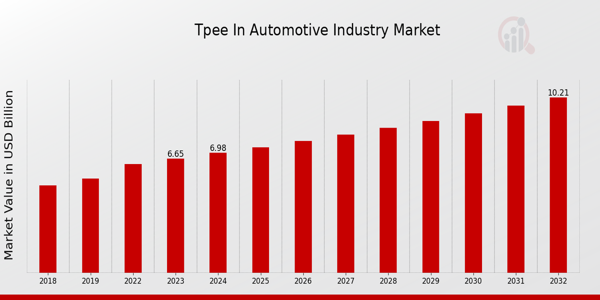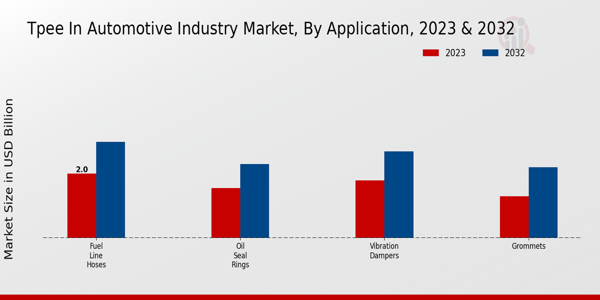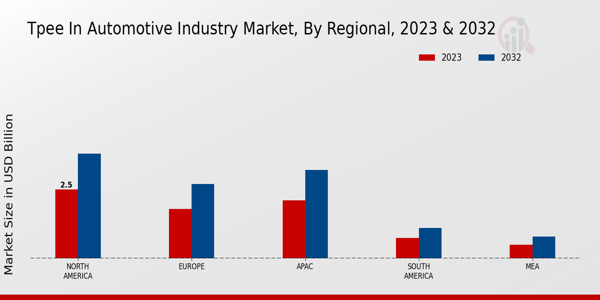Global TPEE in Automotive Industry Market Overview
The TPEE in Automotive Industry Market Size was estimated at 7.31 (USD Billion) in 2024. The TPEE in Automotive Industry is expected to grow from 7.67 (USD Billion) in 2025 to 11.77 (USD Billion) by 2035. The TPEE in Automotive Industry Market CAGR (growth rate) is expected to be around 4.90% during the forecast period (2025 - 2034).
Key TPEE in Automotive Industry Market Trends Highlighted
The growth of the TPEE market in the automotive industry is driven by several factors, including the increasing demand for lightweight materials aimed at improving fuel efficiency and reducing emissions. The need for higher durability and flexibility in automotive components has led manufacturers to opt for thermoplastic elastomers like TPEE. Additionally, the rise in electric vehicles is creating demand for TPEE applications in battery systems and related components due to their excellent thermal stability and chemical resistance.
As the automotive sector shifts towards sustainability, TPEE stands out for its recyclability and lower environmental impact compared to traditional materials.Opportunities abound in the ongoing development of advanced automotive technologies. The shift towards autonomous vehicles and connected technology is prompting a need for materials that can meet higher performance standards, thereby creating an avenue for TPEE innovations. The integration of TPEE in various automotive applications, such as interior parts and under-the-hood components, is an area that can be further explored.
Expanding into emerging markets where automotive manufacturing is on the rise presents another significant opportunity for TPEE producers to capture untapped demand. Recent trends indicate a heightened focus on customization and functional performance in automotive materials.Manufacturers are increasingly looking for solutions that not only meet specific application requirements but also enhance the overall driving experience through improved aesthetics and tactile qualities. Innovations in processing techniques and formulations are gaining traction, allowing for greater design flexibility and performance capabilities.
Additionally, collaborations between automotive companies and material suppliers are becoming more common, emphasizing the importance of long-term partnerships to push the boundaries of what's possible in automotive design and functionality. The advancements in TPEE technology align with the automotive industry’s goals of innovation, efficiency, and sustainability, positioning TPEE as a crucial player in the future of vehicle manufacturing.

Source: Primary Research, Secondary Research, Market Research Future Database and Analyst Review
TPEE in Automotive Industry Market Drivers
Growing Demand for Lightweight Materials
The TPEE in Automotive Industry Market is significantly driven by the increasing demand for lightweight materials in automotive manufacturing. The automobile industry is increasingly focusing on improving fuel consumption and reducing pollutants, and as a result of this trend, there is a growing trend toward harsh plastics such as thermoplastic elastomers (TPEE). These materials enable the creation of light-weighted structures which enhances vehicle performance without loss of safety features because of their high strength-to-weight ratio.
Technological advancement in the automobile industry, coupled with the need to be environmentally friendly, will make the use of weaker materials mandatory. On top of that, the possibility of molding TPEE into complicated shapes enhances the design options available for automotive components and allows manufacturers to exercise reasonable creativity within the stringent parameters they have to work with. Moreover, the increasing popularity of hybrid and electric cars, which require lightweight parts for high efficiency, further adds to this driver.
With the TPEE in the Automotive Industry Market continuing to change, its importance for the achievement of weight targets will always determine how the market will grow.
The Increasing Electric Vehicle (EV) Production
The rising production of electric vehicles (EVs) is another significant driver of growth in the TPEE in Automotive Industry Market. With efforts to promote sustainable transportation and reduce reliance on fossil fuels, manufacturers are turning to TPEE for its versatility and performance characteristics. TPEE is well-suited for various components in EVs, including battery housings, insulation materials, and flexible connectors, as it can withstand the specific challenges posed by electric powertrains.The growth of the EV market not only enhances the application scope for TPEE but also promotes innovations in automotive design and safety, further propelling the demand for these advanced materials.
Rising Consumer Demand for Innovative Features
The shift in consumer preferences towards vehicles equipped with advanced features and technologies is driving the TPEE in Automotive Industry Market. As consumers increasingly prioritize comfort, safety, and aesthetics in their vehicle purchases, automakers are challenged to incorporate innovative components that satisfy these demands. TPEE provides an ideal solution due to its excellent mechanical properties, flexibility, and ability to be molded into intricate designs.This allows manufacturers to create innovative interior features, such as soft-touch surfaces and ergonomic designs, while also meeting safety requirements.
The ongoing trend of integrating technology and luxurious features into vehicles directly influences the demand for TPEE applications, thereby contributing to the overall growth of the market.
TPEE in Automotive Industry Market Segment Insights
TPEE in Automotive Industry Market Application Insights
The TPEE in Automotive Industry Market, particularly within the Application segment, demonstrates a robust and evolving landscape that encompasses various essential components crucial for automotive functionality and performance. The overall valuation reached 6.65 USD Billion in 2023, reflecting the growing demand for thermoplastic elastomeric polyether blends across multiple applications within the automotive industry. Amongst the various applications, Fuel Line Hoses stand out with a valuation of 2.0 USD Billion in 2023 and are projected to grow to 3.0 USD Billion by 2032, showcasing their significant role in ensuring fuel transfer efficiency and compliance with stringent environmental regulations.
This segment holds a majority share due to the increasing focus on fuel efficiency and emission controls in modern vehicles.Simultaneously, Oil Seal Rings, valued at 1.55 USD Billion in 2023 and expected to rise to 2.3 USD Billion in 2032, play an essential role in preventing leaks and ensuring the integrity of engine components. Their growth can be attributed to advancements in engine technologies and the demand for improved reliability in vehicle performance.
The significant utilization of Oil Seal Rings across various automotive applications emphasizes their importance in maintaining overall vehicular efficiency.Additionally, the Vibration Dampers category, which was valued at 1.8 USD Billion in 2023, is expected to experience an increase to 2.7 USD Billion by 2032. Vibration Dampers are crucial for enhancing passenger comfort by minimizing noise and vibrations during vehicle operation.
This segment’s growth is supported by the mounting emphasis on passenger comfort and the necessity for smoother rides in the automotive industry, making it a critical aspect of modern automotive design.Lastly, the Grommets segment, with a valuation of 1.3 USD Billion in 2023 and an increase to 2.2 USD Billion anticipated by 2032, holds a more niche role but is still essential for ensuring connections and preventing fraying of cables and hoses within vehicles.
Their relatively smaller share highlights specialized uses yet underscores a consistent demand driven by innovations in automotive electronics and integrated systems.In summary, the TPEE in Automotive Industry Market showcases a diverse range of applications, each essential for various automotive operations. With dynamic growth patterns driven by industry needs for efficiency, safety, and enhanced performance, this segment not only reflects the overall market health but also indicates significant opportunities for expansion within sub-segments as technology and consumer preferences evolve.
Each component underscores an increasing reliance on TPEE materials, marking a distinctive and essential evolution in the automotive industry focused on meeting modern challenges.

Source: Primary Research, Secondary Research, Market Research Future Database and Analyst Review
TPEE in Automotive Industry Market Automotive Type Insights
The TPEE in Automotive Industry Market presents a diverse spectrum within the Automotive Type segment, which plays a crucial role in driving market growth. In 2023, this market will be valued at 6.65 USD Billion, reflecting the increasing demand for advanced materials in vehicles. An essential area within this market is Passenger Vehicles, which consistently show substantial growth due to consumer preference for comfort and fuel efficiency.
Moreover, the rise of Electric Vehicles has emerged as a significant factor, driven by the shift towards sustainable energy solutions and stringent environmental regulations.The Commercial Vehicles segment experiences demand largely due to advancements in logistics and transportation efficiency, underscoring the importance of reliable materials. Hybrid Vehicles also hold a vital position, combining the benefits of both conventional and electric powertrains. The TPEE in Automotive Industry Market segmentation showcases a myriad of opportunities and challenges, with an emphasis on innovation and adaptation to evolving consumer needs.
Market statistics reveal that as the automotive industry pivots towards more eco-friendly alternatives, the demand for TPEE materials is expected to only strengthen, ensuring their lasting influence in the automotive landscape.
TPEE in Automotive Industry Market Material Type Insights
The TPEE in Automotive Industry Market is valued at 6.65 Billion USD in 2023, reflecting the increasing demand for advanced materials in automotive applications. The segmentation of this market by Material Type includes Polyether-based TPEE, Polybased TPEE, and Aromatic TPEE, each holding significant importance. Polyether-based TPEE is well-regarded for its elasticity and chemical resistance, which makes it ideal for various automotive components. In comparison, Polybased TPEE is recognized for its excellent thermal stability and durability, driving its usage in high-performance applications.Aromatic TPEE stands out due to its rigidity and strength, making it a preferred choice for structural applications in vehicles.
With the automotive industry continuously innovating and focusing on lightweight yet robust materials, the TPEE in Automotive Industry Market data shows a steady growth trend, supported by the rising demand for eco-friendly solutions and advancements in automotive technologies. The market faces challenges such as fluctuating raw material prices and competition from alternative materials; however, opportunities remain for manufacturers to innovate and cater to emerging market needs, contributing to the overall market growth and evolving TPEE in Automotive Industry Market statistics.
TPEE in Automotive Industry Market End Use Insights
In 2023, the TPEE in Automotive Industry Market is valued at 6.65 billion USD, showcasing robust growth as the market adapts to evolving industry demands. The End Use segment reveals a structured division primarily into OEM and Aftermarket applications, both critical in driving market innovation and revenue. OEM plays a pivotal role as automotive manufacturers increasingly opt for TPEE for its lightweight and flexible properties, leading to enhanced vehicle performance and energy efficiency.
On the other hand, the Aftermarket segment is gaining traction as consumers seek premium replacements and enhancements for vehicle longevity.The growing trend towards electric vehicles and stringent emissions regulations further underscores the relevance of TPEE materials. As the TPEE in Automotive Industry Market enjoys steady growth fueled by such trends, the segmentation within this market, alongside the pressing needs for sustainability and performance, offers substantial opportunities for stakeholders to capitalize on, reinforcing the importance of understanding TPEE in Automotive Industry Market data and statistics for strategic growth and competitiveness.
TPEE in Automotive Industry Market Regional Insights
The TPEE in Automotive Industry Market revenue highlights a dynamic landscape with significant valuations across various regions. In 2023, North America leads the market with a valuation of 2.5 USD Billion, followed closely by APAC at 2.1 USD Billion, indicating their strong demand for thermoplastic elastomers in automotive applications. Europe has an estimated value of 1.8 USD Billion, showcasing its substantial contribution to the market.
South America and MEA, while smaller, have respective valuations of 0.75 USD Billion and 0.5 USD Billion, pointing to emerging opportunities in these regions.The growth in North America is largely driven by the ongoing advancements in automotive manufacturing technology, while APAC's significant share reflects its robust automotive production capacity. Europe's focus on innovative automotive solutions further strengthens its market position. Collectively, these regions provide a comprehensive overview of the TPEE in Automotive Industry Market segmentation, highlighting a sustained growth trajectory and the potential for new opportunities in a rapidly evolving industry.

Source: Primary Research, Secondary Research, Market Research Future Database and Analyst Review
TPEE in Automotive Industry Market Key Players and Competitive Insights
The TPEE in Automotive Industry Market is a dynamic and evolving sector characterized by increasing demand for advanced materials that offer enhanced durability, flexibility, and thermal resistance. As automotive manufacturers pursue innovative designs and improved vehicle performance, TPEE has emerged as a key player due to its unique properties that cater to specific requirements in automotive applications. The competitive landscape of this market is shaped by various factors, such as technological advancements, supply chain dynamics, evolving consumer preferences, and regulatory influences, which collectively drive the strategies and positioning of different players within the industry.
Companies operating in this space continually seek to differentiate themselves through product innovation, sustainability initiatives, and strategic partnerships to capitalize on market opportunities.DOW maintains a significant presence in the TPEE in Automotive Industry Market, showcasing a robust portfolio of high-performance materials that cater specifically to the needs of automotive applications. The company leverages its extensive research and development capabilities to drive innovation, focusing on creating tailored solutions that enhance vehicle efficiency, reduce weight, and improve overall performance. DOW's strong brand recognition and commitment to sustainable practices further fortify its competitive edge, making it a preferred partner for automotive manufacturers.
With a manufacturing footprint and strategic collaborations, DOW effectively addresses the diverse needs of the automotive industry while consistently investing in advanced technologies and materials to uphold its leadership position within the TPEE market.Wacker Chemie is another prominent player in the TPEE in Automotive Industry Market, distinguished by its focus on providing high-quality polymer solutions. The company's products are designed to meet the stringent demands of the automotive sector, particularly in applications requiring outstanding performance and environmental resistance.
Wacker Chemie's strong emphasis on innovation is reflected in its continuous development of new formulations and applications that cater to the evolving requirements of automotive manufacturers. With a commitment to sustainability, the company has initiated programs aimed at reducing environmental impacts while enhancing product performance. As a result, Wacker Chemie's established reputation for quality and reliability makes it a formidable competitor in the TPEE space within the automotive industry, contributing to the growing trend of adopting advanced materials for enhanced vehicle design and functionality.
Key Companies in the TPEE in Automotive Industry Market Include
TPEE in Automotive Industry Market Industry Developments
Recent developments in the TPEE in Automotive Industry Market highlight significant advancements and shifting dynamics among key players such as DOW, Wacker Chemie, Eastman Chemical, and others. Notably, DOW has continued to expand its automotive material solutions, focusing on lightweight applications that enhance vehicle efficiency. Meanwhile, Wacker Chemie has introduced innovative TPEE formulations aimed at improving thermoplastic performance and sustainability, leveraging their advanced polymer technology. In parallel, Merger and acquisition activity has stirred interest, with several companies actively exploring strategic partnerships to bolster their market positions.
For instance, Eastman Chemical is in discussions regarding potential acquisitions to enhance its TPEE portfolio, while BASF has completed an acquisition aimed at broadening its product offerings in the automotive sector. The market has also been influenced by companies such as LG Chem and Samsung SDI, which are investing heavily in advanced materials to support the growing electric vehicle segment. Overall, as the demand for lightweight, durable, and sustainable materials continues to surge, the TPEE market is witnessing robust growth, driving companies like PolyOne, Solvay, and Celanese to innovate and adapt their strategies accordingly.
TPEE in Automotive Industry Market Segmentation Insights
TPEE in Automotive Industry Market Application Outlook
TPEE in Automotive Industry Market Automotive Type Outlook
TPEE in Automotive Industry Market Material Type Outlook
TPEE in Automotive Industry Market End Use Outlook
TPEE in Automotive Industry Market Regional Outlook
| Report Attribute/Metric |
Details |
| Market Size 2024 |
7.31 (USD Billion) |
| Market Size 2025 |
7.67 (USD Billion) |
| Market Size 2034 |
11.77 (USD Billion) |
| Compound Annual Growth Rate (CAGR) |
4.90% (2025 - 2034) |
| Report Coverage |
Revenue Forecast, Competitive Landscape, Growth Factors, and Trends |
| Base Year |
2024 |
| Market Forecast Period |
2025 - 2034 |
| Historical Data |
2019 - 2023 |
| Market Forecast Units |
USD Billion |
| Key Companies Profiled |
DOW, Wacker Chemie, Eastman Chemical, Mitsui Chemicals, PolyOne, Solvay, SABIC, Celanese, Mitsubishi Chemical, Hexpol, Kraton, BASF, Samsung SDI, LG Chem, Evonik |
| Segments Covered |
Application, Automotive Type, Material Type, End Use, Regional |
| Key Market Opportunities |
Growing demand for lightweight materials, Increasing focus on sustainability initiatives, Rise in electric vehicle production, Advancements in TPEE processing technologies, Expanding applications in interior components |
| Key Market Dynamics |
Rising lightweight materials demand, Growing electric vehicle adoption, Increased fuel efficiency regulations, Enhancements in thermal stability, Expanding manufacturing capabilities |
| Countries Covered |
North America, Europe, APAC, South America, MEA |
Frequently Asked Questions (FAQ):
The TPEE in the Automotive Industry Market is expected to be valued at 11.77 USD Billion by 2034
The expected CAGR for the TPEE in the Automotive Industry Market is 4.90% from 2025 to 2035.
The Fuel Line Hoses application is expected to have the highest market value at 3.0 USD Billion by 2032.
The Oil Seal Rings application is projected to reach a market value of 2.3 USD Billion by 2032.
North America is expected to dominate the market with a value of 3.8 USD Billion by 2032.
The Vibration Dampers application is anticipated to reach a market size of 2.7 USD Billion by 2032.
The Grommets application is expected to have a market value of 2.2 USD Billion by 2032.
The market size for North America in 2023 is valued at 2.5 USD Billion.
Major players in the market include DOW, Wacker Chemie, Eastman Chemical, and Mitsui Chemicals.
The market size for South America is expected to reach 1.1 USD Billion by 2032.

















